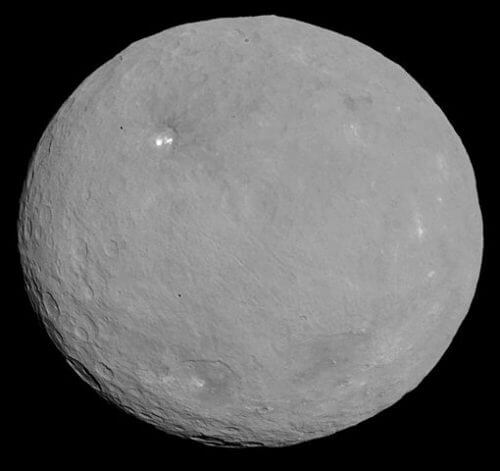From data from the Dawn spacecraft orbiting Ceres, it appears that its subsoil is still unstable and carbon compounds have risen to the surface and created large spots

The presence of certain chemical compounds on the surface of the collapsed dwarf star shows that it is still developing. This is according to a study conducted by a team led by Filippo Giacomo Carruzzo from the Italian Institute of Astrophysics and Planetology.
Team members used data produced by the infrared spectrometer on NASA's Dawn spacecraft to map the chemical composition of the dwarf planet orbiting the Sun in the asteroid belt between Mars and Jupiter.
Previous studies and data from the Dawn spacecraft confirmed the presence of carbon compounds on the planet's surface. Carbon compounds are the most diverse and widespread group of minerals on Earth, and originate from sedimentary rocks.
It is assumed that the discovery of carbon compounds on other planets is evidence that liquid water once existed all over the planet.
In an article published in the journal Science Advances,, The team reports that these compounds are found everywhere on a hook, with the most common version being that of a magnesium-carbon compound.
However, the researchers also report the presence of sodium carbonate, specifically a compound called nitrite (Na2CO3). This was unexpected because if Ceres was nothing more than a dead planet, the compounds should have evaporated after millions of years.
Instead, they are present in areas of approximately one square kilometer mostly near impact craters with domes and piles. In some of the craters you can also see signs on the bottom.
The finding led the researchers to the conclusion that the sodium-carbon compounds may have been pushed to the surface in liquids that came up from underground. It turns out that the underground of Ceres is buzzing with activity because the dwarf planet is expanding.
Carruzzo and his colleagues indicate that these large spots were formed in the last million years, and that the process of their gradual evaporation is still underway.
In the same topic on the science website:

2 תגובות
After all, it is clearly written in the last sentence of the article that:
"Carozzo and his colleagues indicate that these large spots formed in the last million years, and that their gradual evaporation process is still underway."
Therefore, if it is an evaporation process, then the title should be:
"Collapsed Dwarf Planet Still ... Small"
Not "growing" and not "active" but .... "small". Yes?
my father
Instead of the title "Dwarf planet Keres is still growing", it would have been better in my opinion "Dwarf planet Keres is still active". Active instead of growing.
That's my opinion. for your judgment.
Good Day
Yehuda